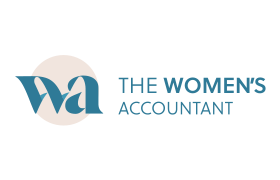Why You Can Run a ‘Profitable’ Business
and Still Feel Broke
Ever feel like your profit & loss is lying to you?
Here’s why your bank balance doesn’t match your P&L
—and what it actually tells you about your business.

Emma Bowdler
I’m a cheerleader for women and an accountant bursting with personality.
If your profit line looks pretty good but your bank account looks bare…welcome to the club. No, you’re not imagining it—and no, your P&L isn’t gaslighting you. But it is working with a different set of rules to your bank balance. That’s because your P&L and your bank balance are frenemies, not twins.
So if you’ve ever squinted at your Xero backend wondering why you’re supposedly rolling in profit while your cash feels more like a slow drip than healthy flow, this one’s for you.
First Things First: What’s a P&L
Actually Showing You?
Your Profit and Loss Statement—aka P&L, aka income statement, aka the ‘am I making money or just vibes?’ report—is one of the core financial reports in your business. It shows you your revenue (money in) and your expenses (money out) over a specific period of time—like a month, a quarter, or a full financial year.
Think of your P&L like a high-level highlight reel of your business performance. It helps you answer questions like:
- Am I actually turning a profit?
- What’s eating into my earnings?
- Are my sales covering my expenses?
- Do I need to tweak my pricing, cut costs, or sell more?
But—and this is important—it doesn’t show you everything. That’s where things like your cash flow statement and bank balance come in.
So why don’t they match? Five reasons, coming right up…
1. Accrual Accounting:
The Ultimate Timing Mismatch
Most accounting software and P&Ls run on what’s called ‘accrual accounting’, which is all about timing. That means income and expenses are recorded when they’re earned (when you send the invoice), not when the money *actually* lands (or leaves) your account.
So, you might have invoiced $5K worth of work that hasn’t been paid yet. That income? Already showing on your P&L. Or, you might have received a $2K bill that you haven’t paid yet. That expense? Also sitting on your P&L. Meanwhile, your cash accounting brain is doing your best Rihanna “b*tch, better have my money” impression, because until that money actually hits (or leaves) your account, you won’t see the impact.
Accrual Vs Cash Accounting
— Two Ways of Tracking Your Money
Not sure what all this means? Basically, accrual accounting gives you a fuller picture of how your business is performing over time. It’s great for forecasting and understanding long-term profitability. But it can also be confusing because your P&L might look like you’re raking it in…even if your bank account says “it’s two-minute noodles for dinner again”.
Most accounting software defaults to accrual because it’s required for tax reporting once you hit certain thresholds (over $10M turnover or if you’re carrying inventory, for example). But many small businesses start out on cash accounting because it’s easier to follow. Here’s a quick compare-the-pair (no meerkats):
| Accrual Accounting | Cash Accounting | |
| Income recorded | When you invoice (earned) | When it’s paid (received) |
| Expenses recorded | When it’s billed (incurred) | When it’s paid |
| Matches bank balance? | Not usually | Much more closely |
| Commonly used for: | Growing businesses, tax planning | Small businesses, simpler reporting |
So if you’re ever feeling like your P&L is speaking a whole different language than your bank account—she probably is. Accrual is speaking in future tense, while cash accounting is all about the here and now; one on promises, the other on payments.
2. GST and Tax: The Invisible Money Leaks
If you ever feel personally attacked by your bank balance every BAS quarter or tax season…you’re not alone. One of the biggest reasons your profit doesn’t feel like cold, hard cash in your pocket is because your P&L doesn’t show what you owe the ATO, specifically, GST and income tax. Huh? Ok, basically:
- GST isn’t included as an expense on your P&L
- Income tax is a liability, not an expense, so it lives on your balance sheet instead
Confoosed? We gotchu. If you’re registered for GST and you earned $11,000 on a project, including GST—$1,000 of that is tax you have to hand over to the ATO. While that chunk disappears from your bank account eventually, it never shows up on your P&L because that portion belongs to the tax office, not you. #rude
Likewise with income tax. This one trips up a lot of business owners. Your P&L shows your pre-tax profit—but it doesn’t show your income tax obligations at all. Why? Because income tax isn’t considered a business expense. It’s a liability, meaning it sits on your balance sheet, not your P&L.
So even if your P&L says “slayyyy queen, you made $100K!”, that doesn’t mean all that money is yours to play with. You could still owe a sizeable chunk of that to the ATO come tax time—and your P&L won’t breathe a word of warning.
Are you seeing profit on paper but struggling to pay your BAS or tax bill? You’re not bad at business—you’re just missing the full picture.
A smart cash flow plan should always factor in these behind-the-scenes payments.
3. Loan Repayments: Cash Out, Not on the P&L
Let’s talk loans. When you borrow money in your business, whether it’s for new equipment, a vehicle, or just to keep the wheels turning during a tough patch, chances are you’re making monthly repayments. But here’s the twist: your full loan repayment doesn’t show up as an expense on your P&L.
Here’s what’s actually going on: loan repayments are split into two parts → principal (the actual loan amount) and interest. Only the interest makes it onto your P&L. The principal portion, meanwhile—she’s ghosting your P&L and draining your bank account.
So while you’re watching hundreds—or thousands—leave your bank account each month, your P&L is giving you the rose-coloured version of events. This is a common trap for business owners who run lean and rely heavily on cash flow to stay afloat. If you don’t factor in your loan repayments when looking at your monthly numbers, you might think you can afford something you absolutely cannot (been there, done that, maxed out the overdraft.)
Pro tip: If you’ve got loans, build repayment schedules into your cash flow planning—even if your P&L isn’t showing them. Your future self will thank you.
4. Drawings and Dividends:
Not an Expense, But Still a Drain
If you’re a sole trader taking drawings or a Company Director paying yourself dividends, guess what? That’s not considered a business expense either. Why? Because these payments are technically a withdrawal of equity (drawings) or a return on investment (dividends), which means they live over on your balance sheet.
Yep. That $3K you transferred to your personal account to cover bills or treat yourself to a weekend away? Doesn’t touch the P&L. But it does touch your cash flow. Hard.
And here’s where things get spicy: you’ll still pay income tax on your profit, even if you’ve already drawn that money out and spent it. So if your business shows a $50K profit but you’ve already withdrawn (and spent) $45K? You still owe tax on the $50K. It’s a recipe for tax-time panic if you’re not prepared.
Your Business BFF tip? Get clear on what you actually need to keep the lights on each month. Set up a consistent drawing strategy, and factor that into your cash flow. Random withdrawals = skyrocketing stress.
5. Asset Purchases:
Your Gear is Hiding from the P&L
Bought a new laptop, office equipment, or vehicle lately? Unless it’s a small purchase under the instant asset write-off threshold, it won’t show up as an expense on your P&L. So essentially, your bank account takes the hit right away. But your P&L? She barely flinches and just spreads out the love slowly. Why? Because assets aren’t treated like regular expenses.
Instead of writing off the whole cost in one go, asset purchases are:
- Logged as capital assets on your balance sheet, and
- Depreciated over time (usually several years), based on ATO rules
So your $10K purchase might only show up as a $2K depreciation expense this year (if that), even though you paid the full amount upfront. This mismatch between what you spent and what your P&L shows can be super confusing—and it’s one of the biggest reasons people think their P&L is “lying to them”.
The workaround? Keep a separate cash flow plan for major purchases and talk to your accountant (hi, hello, it’s us 👋!) about what you can claim (and when). Especially if you’re planning big investments before EOFY—you don’t want to assume a full deduction and then get caught out.
So… Which One Should You Trust?
Trick question. You need both. Your P&L shows your business’s profitability. Your cash flow (and bank balance) shows how much money you actually have to work with.
Ignoring either one is kinda like trying to drive with one eye closed.
How to Find Your P&L
in Xero 📊
If you’re using Xero (and we really hope you are!), here’s how to find your P&L in just a few clicks:
- Log in to your Xero dashboard.
- From the main menu, head to Accounting > Reports.
- Under “Financial,” select Profit and Loss.
- Choose your date range
—e.g. ‘This Month,’ ‘Last Quarter’ or custom dates. - Click Update to generate your report.
If you want to get nerdy, you can compare it to previous periods using the “Compare With” dropdown. You can also click into any figure on the P&L to see the detailed transactions behind it. The stuff dreams are made of (just us?).
Pro tip: Most P&Ls in Xero default to accrual accounting, so keep that in mind when comparing it to your bank balance. If you want to see it on a cash basis, click the “More” button at the top and change the accounting method.
If you’re ever unsure what your numbers are really telling you—ask your accountant.
That’s what we’re here for!
Reach out to The Women’s Accountant today.
The Business BFF Bottom Line
As your friendly (and fun!) neighbourhood accountants, here’s what we want you to remember about the difference between P&Ls and cash flow:
★ A healthy profit doesn’t automatically mean healthy cash flow
★ Just because it’s not on your P&L doesn’t mean it’s not draining your bank account
★ The better you understand your numbers, the better you can actually run your business. Because understanding your finances? That’s business power, baby!
🎧 Listen to Our Podcast
Ready to Go Deeper?
If this topic made you go “ooohhh, now I get it,” we’ve got plenty more juicy explainers where that came from over on the Business BFF pod.
Tune in to the full episode: Why Doesn’t My Profit and Loss Match My Bank Account? or head to our Resource Library for more handy checklists and straight-talking money magic.
Stop Making These Tax Time Mistakes (and What to Do Instead)
Stop Making TheseTax Time Mistakes(and What toDo Instead) You work too hard to let tax time drain your energy (or your bank account). Avoid these common business tax mistakes before you leave more money on the table. Emma BowdlerI’m a cheerleader for women and an...
Need to Break Up with a Client? How to Know When It’s Time to Cut Ties and How to Do It with Kindness
Need to Break Up with a Client?How to Know When It's Time to Cut Ties and How to Do It with Kindness Not every client is a keeper. Here’s how to spot clients who are no longer a fit, set boundaries like a boss, and break up with them (kindly). Emma BowdlerI’m a...
What’s The Deal With Registered Tax Agents? And Why It Matters For Your Biz
What’s The Deal With Registered Tax Agents? And Why It Matters For Your Biz The lowdown on registered tax agents, why working with one is crucial for business success, and red flags to help you spot a dodgy one before drama strikes. Emma BowdlerI’m a cheerleader for...





